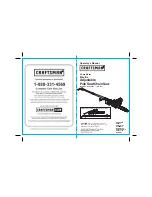
17
100647 - ChAiNSAw
OPERATiON
–
Use these hand placements whether the operator is left-
handed or right-handed. This will help keep the operator
slightly to the left of the unit and out of the direct line of the
chain saw if kickback occurs (Fig. 7 and Fig. 8).
–
Stand in a stable position with feet apart and firmly planted.
–
Do not cut above shoulder height. Do not over reach.
Correct Grip
Thumbs below the handles
Figure 6
Chain line
Correct Stance
Figure 7
Chain line
Incorrect Stance
Figure 8
Cutting Procedure basics
1. Start the unit. Refer to
Starting Instructions
in the
Starting and
Stopping
section.
2. Keep your fingers off the throttle control until you are ready to
make a cut.
3. Accelerate the unit to full speed before cutting.
4. Press the unit against the wood and maintain a firm, steady
pressure through most of the cut. Do not put pressure on the
unit at the end of the cut.
5. Maintain a steady speed throughout the cut. Keep the unit
running through the entire cut.
6. Do not try to force the saw through the wood. Allow the saw
chain to do the cutting. Exert only light pressure. Forcing the
cut could result in damage to the unit or personal injury.
7. Release the throttle control as soon as the cut is completed.
Allow the saw chain to come to a complete stop. The saw
chain, guide bar and engine may experience unnecessary
wear if the unit is run without a cutting load.
felling: Safety
Felling is the process of cutting down a tree. Follow these safety
precautions to reduce the risk of serious injury, property damage
and damage to electrical lines:
–
Do not fell trees with an extreme lean. Do not fell trees with
rotten limbs, loose bark or hollow trunks. Have these trees
pushed or dragged down with heavy equipment.
–
Do not cut trees near buildings or electrical lines. Leave these
operations for professionals. If a felled tree does contact an
electrical line, notify the utility company immediately.
–
Check the tree for damaged or dead branches that could fall
and cause serious injury.
–
Remove dirt, stones, loose bark, nails, wire and other
obstructions from the portion of the tree that will be cut.
–
When bucking and felling operations are performed by two
or more persons in the same general area, they should be
separated from each other by a distance of at least twice the
height of the tree to be felled.
–
Consider the force and direction of the wind. Consider the
lean and balance of the tree. Consider the location of large
branches. All of these factors influence the direction that the
tree will fall. Do not try to fell a tree in a direction other than its
natural fall line.
–
Do not fell trees during periods of precipitation or high winds.
–
Determine a safe and expedient escape route. Clear the area
around the tree and make sure there are no obstructions
blocking the escape route. Establish a 90º corridor of escape,
approximately 135º from the line of fall (Fig. 9).
–
Stay uphill from the tree; it will most likely roll or slide after it
falls.
90°
135° from planned
line of fall
Path of
safe retreat
135° from planned
line of fall
Planned line
of fall
Figure 9
















































